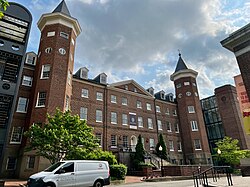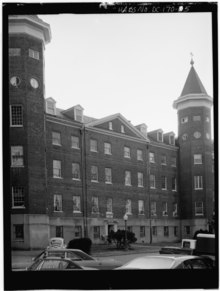
Georgetown University is a private Jesuit research university in Georgetown neighborhood of Washington, D.C., United States. Founded by Bishop John Carroll in 1789 as Georgetown College, it is the oldest Catholic institution of higher education in the United States and the nation's first federally chartered university.

Georgetown is a historic neighborhood and commercial district in Northwest Washington, D.C., situated along the Potomac River. Founded in 1751 as part of the colonial-era Province of Maryland, Georgetown predated the establishment of Washington, D.C. by 40 years. Georgetown was an independent municipality until 1871 when the United States Congress created a new consolidated government for the entire District of Columbia. A separate act, passed in 1895, repealed Georgetown's remaining local ordinances and renamed Georgetown's streets to conform with those in Washington, D.C..
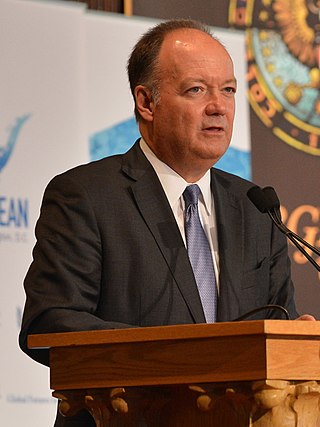
John Joseph DeGioia is an American academic administrator and philosopher who has been the president of Georgetown University since 2001. He is the first lay president of the school and is currently its longest-serving president. Upon his appointment, he also became the first lay president of any Jesuit university in the United States. Having spent his entire career at Georgetown, where he received his undergraduate and graduate degrees, DeGioia was the dean of student affairs and held various vice presidential positions before becoming president.

Patrick Francis Healy was an American Catholic priest and Jesuit who was an influential president of Georgetown University, becoming known as its "second founder". The university's flagship building, Healy Hall, bears his name. Though he considered himself and was largely accepted as White, Healy was posthumously recognized as the first Black American to earn a PhD, as well as the first to enter the Jesuit order and to become the president of a predominantly White university.

Leo Jeremiah O'Donovan III is an American Catholic priest, Jesuit, and theologian who served as the president of Georgetown University from 1989 to 2001. Born in New York City, he graduated from Georgetown, and while studying in France, decided to enter the Society of Jesus. He went on to receive advanced degrees from Fordham University and Woodstock College, and received his doctorate in theology from the University of Münster, where he studied under Karl Rahner. Upon returning to the United States, he became a professor at Woodstock College and the Weston Jesuit School of Theology, before becoming the president of the Catholic Theological Society of America and a senior administrator in the Jesuit Maryland Province.

McDonough Gymnasium, sometimes referred to as McDonough Arena when hosting a sports or entertainment event, is a multi-purpose arena on the campus of Georgetown University in Washington, D.C. Officially known as McDonough Memorial Gymnasium, it opened in 1951 and can hold 2,200 spectators for sports events.

Healy Hall is a National Historic Landmark and the flagship building of the main campus of Georgetown University in Washington, D.C., United States. Constructed between 1877 and 1879, the hall was designed by Paul J. Pelz and John L. Smithmeyer, both of whom also designed the Thomas Jefferson Building of the Library of Congress. The structure is named after Patrick Francis Healy, who was the President of Georgetown University at the time.

Timothy Stafford Healy was an American Catholic priest and Jesuit who straddled the religious and secular life, serving as the vice chancellor of the City University of New York, the president of Georgetown University, and the president of the New York Public Library.

Students of Georgetown Inc., commonly known as "The Corp", is a 501(c)(3) non-profit public charitable organization at Georgetown University in Washington, D.C., with seven subsidiary companies generating annual revenues in excess of $5 million. Only undergraduate students of Georgetown University work as employees or sit as members of the Corp's board of directors, distinguishing business operations at the Corp from other student-run companies such as Harvard Student Agencies, which allows non-students and alumni to serve as board members.
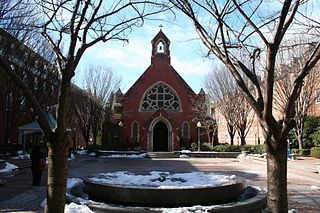
The history of Georgetown University spans nearly 400 years, from the early European settlement of America to the present day. Georgetown University has grown with both its city, Washington, D.C., and the United States, each of which date their founding to the period from 1788 to 1790. Georgetown's origins are in the establishment of the Maryland colony in the seventeenth century. Bishop John Carroll established the school at its present location by the Potomac River after the American Revolution allowed for free religious practice.

The Campuses of Georgetown University, the Law School Campus, the Main Campus, and the Medical Campus, are located within Washington, D.C. Georgetown's Main and Medical Campuses are located in Georgetown, Washington, D.C. between Canal Road, Prospect Street, and Reservoir Road. The Law Campus is located in downtown DC on New Jersey Avenue, near Union Station. Other parts of Georgetown are located in the D.C. Area, including the Center for Continuing and Professional Education at Clarendon in Arlington, Virginia. Georgetown also has an overseas campus in Education City, Qatar, and villas in Alanya, Turkey and Fiesole, Italy.

Jack the Bulldog is the official mascot of the Georgetown University Hoyas athletic teams. The school has employed at least nine live Bulldogs as mascots, and counts seven named Jack since 1962, when the name first came into use, including three who are still living. The current incarnation of Jack, who will be taking over from his predecessor during the spring 2024 semester, is an English Bulldog born in 2023 whose full name is Serchell's John P. Carroll. Recent bulldogs have come from the Georgetown alumni family of Janice and Marcus Hochstetler.

Housing at Georgetown University consists of 13 residence halls at the main campus and a law center campus. Housing on Georgetown's main campus is divided between "halls," usually more traditional dormitories, and "villages", usually less traditional apartment complexes. In addition, Georgetown operates many townhouses in the Georgetown neighborhood, usually for second, third, and fourth-year students.

Bishop John Carroll is a statue by the sculptor Jerome Connor commemorating Archbishop John Carroll, the founder of Georgetown University and the first Catholic bishop in the United States. Located in front of Healy Hall, on university's campus in the Georgetown neighborhood of Washington, D.C., the statue consists of a bronze sculpture of Carroll on top of a granite pedestal.

Dahlgren Chapel of the Sacred Heart, often shortened to Dahlgren Chapel, is a Roman Catholic chapel located in Dahlgren Quadrangle on the main campus of Georgetown University in Washington, D.C. The chapel was built in 1893, and is located in the historic center of the campus.

Gaston Hall is an auditorium located on the third and fourth floors of the north tower of Healy Hall on Georgetown University's main campus in Washington, D.C. Named for Georgetown's first student, William Gaston, who also helped secure the university's federal charter, Gaston Hall was completed in 1901, around twenty years after the construction of the building within which it is housed.
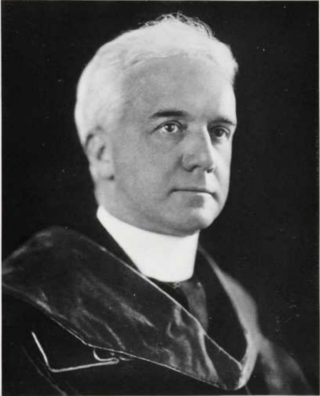
William Coleman Nevils was an American Catholic priest and Jesuit educator who became the head of numerous Jesuit institutions throughout the northeastern United States, including Georgetown University and the University of Scranton. Born in Philadelphia, he was educated at Saint Joseph's College, before entering the Society of Jesus. While studying for the priesthood, he taught at Boston College and the Loyola School. After receiving his doctorate from Woodstock College, he held professorships at St. Andrew-on-Hudson and the College of the Holy Cross, before transferring to Georgetown University, where he became the dean of Georgetown College, the academic vice president, and the regent of the School of Foreign Service. He then left Georgetown to become the dean of the Shadowbrook Jesuit House of Studies.
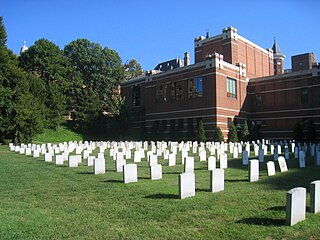
The Jesuit Community Cemetery on the campus of Georgetown University in Washington, D.C., is the final resting place for Jesuits who were affiliated with the university. It was first established in 1808 and was moved to its present location in 1854.

Bernard A. Maguire was an Irish-American Catholic priest and Jesuit who served twice as the president of Georgetown University. Born in Ireland, he emigrated to the United States at the age of six, and his family settled in Maryland. Maguire attended Saint John's College in Frederick, Maryland, and then entered the Society of Jesus in 1837. He continued his studies at Georgetown University, where he also taught and was prefect, until his ordination to the priesthood in 1851.
Kehoe Field is the name of two fields that served as the home of the Georgetown Hoyas intramural sports and varsity athletics teams, including several seasons of Hoyas football, since the 1950s. They occupied the same site, successively, on the Georgetown University campus in Washington, D.C.
